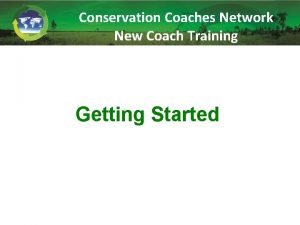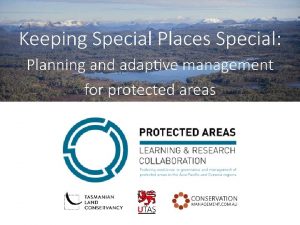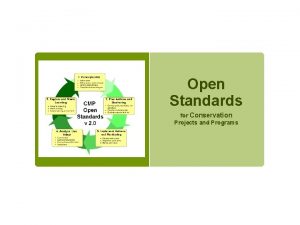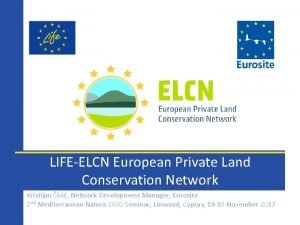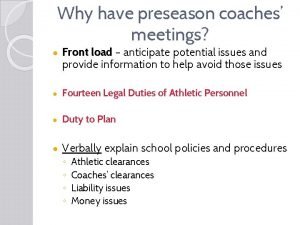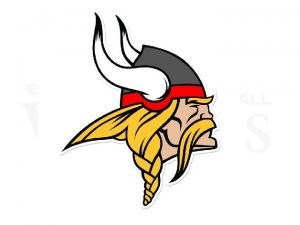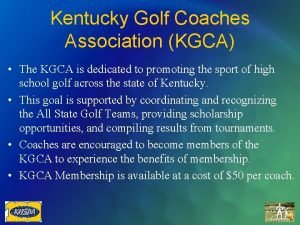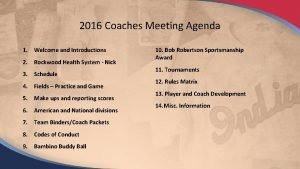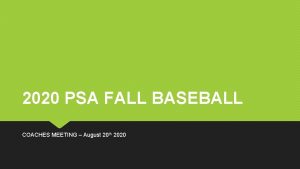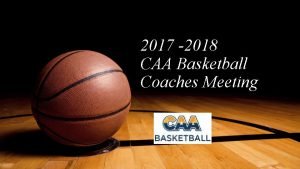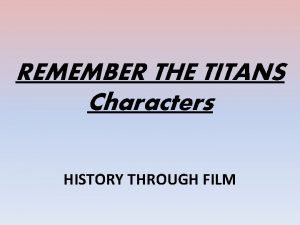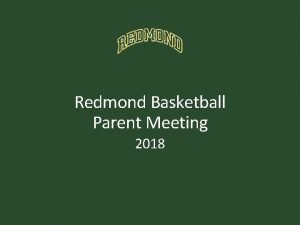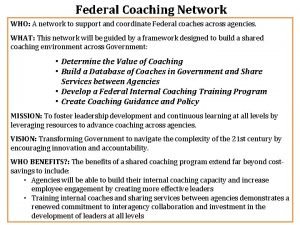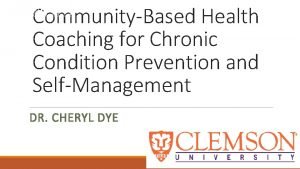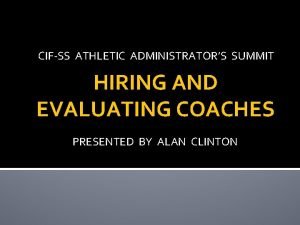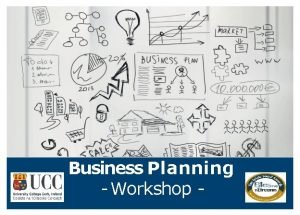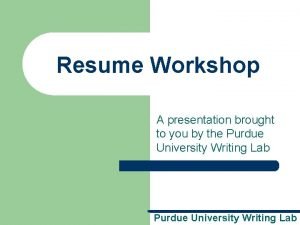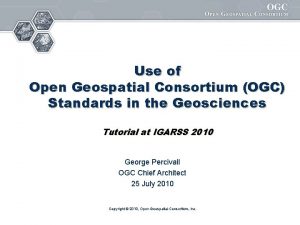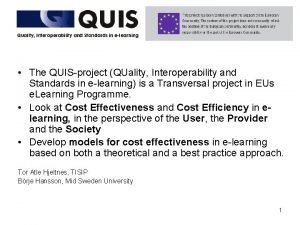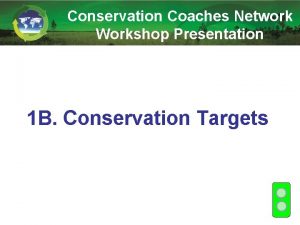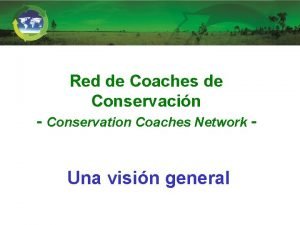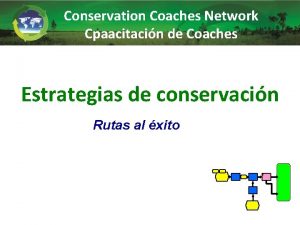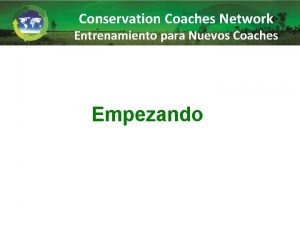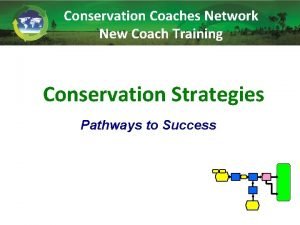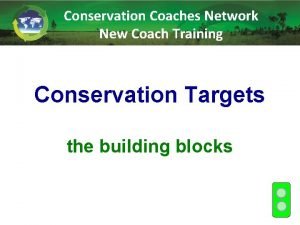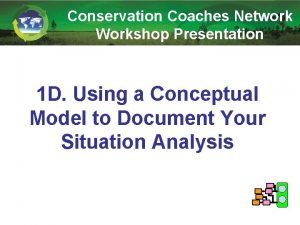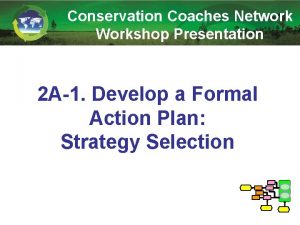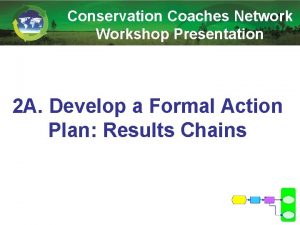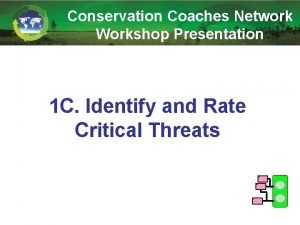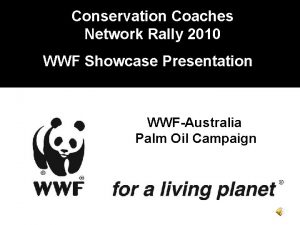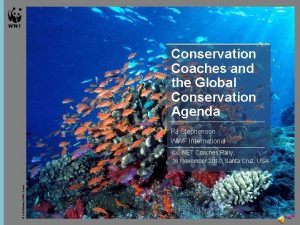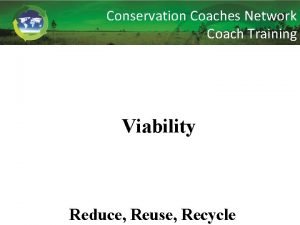Conservation Coaches Network Workshop Presentation The Open Standards































































- Slides: 63

Conservation Coaches Network Workshop Presentation The Open Standards for the Practice of Conservation Planning, Managing, Monitoring, and Learning from Projects (and Programs) at All Scales

CAP Stories from around the World Northern Kenya Rangelands Why we like CAP

Peconic Estuary, New York

Mesoamerican Reef

Whooping Crane Range-wide Conservation Plan

CMP Open Standards for the Practice of Conservation www. conservationmeasures. org

This Presentation • What is adaptive management? • Brief summary of the Open Standards for the Practice of Conservation • Resources available to support implementation of the Open Standards

Why Do Adaptive Management? • Are we achieving an impact? • Are we doing the right things? • Are we doing them well?

What is Adaptive Management? The integration of project or program planning, management, and monitoring to provide a framework for: • Testing assumptions • Learning • Adapting

Adaptive Management Combines Action and Research

Adaptive Management Combines Action and Research

Adaptive Management Combines Action and Research

The Basic Project Management Cycle

Many Versions of Adaptive Management in Practice

The Conservation Measures Partnership (CMP)

Open Standards for the Practice of Conservation • Developed by leading orgs & agencies • Draws on many fields • Open source & common language • Used around the world • • State Wildlife Agencies National Park Systems Donor Funding Programs Academic Training

What is Our Approach to Adaptive Management? www. conservationmeasures. org

This Presentation • What is adaptive management? • Brief summary of the Conservation Measures Partnership’s Open Standards for the Practice of Conservation • Resources available to support implementation of the Open Standards

Brief Summary of the Open Standards 1. Summarize what you want to conserve 2. Understand current & desired condition 3. Identify and rank threats 4. Develop a general model of socioeconomic-ecological system 5. Identify strategies based on the general model 6. Define theories of change to show strategies will work 7. Implement the strategies, checking as you go 8. Adjust

Brief Summary of the Open Standards 1. Summarize what you want to conserve

1. Summarize what you want to conserve

1. Summarize what you want to conserve • • • • Kittiwakes Murres Cormorants Northern fur seal Stellar sea lion Harbor seal Pacific salmon Pollock Spectacled eider Walrus Polar bear Sea otter Kelp forests • 1. Seabirds • 2. Pinnipeds • 3. Pelagic Fish • • • 4. Sea-Ice Ecosystem • • • 5. Sea otter • • Orca • Gray whale Beluga whale Rockfish • Crab Coral & sponge • gardens Juvenile fish & • shellfish Herring Pribilof rock sandpiper Pribilof shrew • Pribilof arctic fox • Aleutian whitlow grass Black-footed brown lemming Passerines 6. Whales 7. Bottom Dwelling Fish & Crabs 8. Coastal Lagoons 9. Maritime Island Tundra

Brief Summary of the Open Standards 1. Summarize what you want to conserve 2. Understand current & desired condition

2. Understand Current & Desired State of What You Want to Conserve What do you want to conserve? What is your best estimate of how it’s doing? Viability Summary East Molokai Targets Landscape Context Condition Size Viability Rank 1 North Shore Forests & Cliffs Fair Good Fair 2 Montane Wet Forest Fair Very Good Fair Good 3 South Slope Mesic Forest & Shrubland Poor Good Poor Fair Overall Biodiversity Health Rank Fair

2. Understand Current & Desired State of What You Want to Conserve POOR Current Status FAIR GOOD 5 -yr Interim Objective 10 -yr Interim Objective VERY GOOD Long-term Desired Status Historical* Level

Brief Summary of the Open Standards 1. Summarize what you want to conserve 2. Understand current & desired condition 3. Identify and rank threats

3. Identify and Rank Threats Operation of Dams Unsustainable harvest Unsustainable Logging Exotic/Invasive Species Residential Development Incompatible Livestock Grazing Photo: Adrian Jones, IAN Image Library

3. Identify and Rank Threats

Brief Summary of the Open Standards 1. Summarize what you want to conserve 2. Understand current & desired state of conservation 3. Identify and rank threats 4. Develop a general model of socioeconomic-ecological system

4. General model of socioeconomicecological system

4. General model of socioeconomicecological system

4. General model of socioeconomicecological system

4. General model of socioeconomicecological system

4. Develop a General Model of Socioeconomic-Ecological System

4. Develop a General Model of Socioeconomic-Ecological System

Brief Summary of the Open Standards 1. Summarize what you want to conserve 2. Understand current & desired condition 3. Identify and rank threats 4. Develop a general model of socioeconomic-ecological system 5. Identify strategies based on the general model

5. Identify Strategies Based on the General Model

5. Identify Strategies Based on the General Model Create market incentives for best practices

Brief Summary of the Open Standards 1. Summarize what you want to conserve 2. Understand current & desired condition 3. Identify and rank threats 4. Develop a general model of socioeconomic-ecological system 5. Identify strategies based on the general model 6. Define theories of change to show strategies will work

6. Theories of Change to Show How Strategies Will Work Human Wellbeing Necessary Material Health Security Good Social Relations Freedom & Choice

6. Theories of Change to Show How Strategies Will Work

6. Theories of Change to Show How Strategies Will Work

6. Theories of Change to Show How Strategies Will Work

Example of a Real Theory of Change

Example of a Real Theory of Change

Example of a Real Theory of Change

Example of a Real Theory of Change Measurable Goal: By 2025, there will be a 10% increase in the survival of leatherback and green turtles into the Go. C compared to 2005 levels. Indicator: Abundance Index Method: Counting of nesting turtles Date: Every three years, starting in 2007 Responsible Entity: Turtle camps personnel Place: Baja California Sur and Michoacán turtle camps

Example of a Real Theory of Change Measurable Objective: By 2012, 90% of the Gulf’s artisanal longliner fleet will operate with circle hooks. Indicator: Percentage of boats using circle hooks Measurable Objective: By 2009, we will have a proven method (circular hooks) to significantly reduce marine turtle bycatch from the artisanal longline fleets from 12 locations on the Mexican Pacific. Measurable Objective: By 2010, at least 220, 000 circular hooks will have been exchanged for the same number of type “J” hooks in the artisanal longliner fleet in the Go. C. Indicator: Circular hooks bycatch rate for marine turtle Indicator: Number of “J” hooks exchanged for circular hooks

Example of a Real Theory of Change Activity Planning: By July 2008, carry out 10 three-day fishing trials in three different locations using circular hooks. Publish full report by November 2008. Activity Planning: By January 2009, develop, staff, publicize and initiate major hooks exchange campaign initiative in three regions.

Brief Summary of the Open Standards 1. Summarize what you want to conserve 2. Understand current & desired condition 3. Identify and rank threats 4. Develop a general model of socioeconomic-ecological system 5. Identify strategies based on the general model 6. Define theories of change to show strategies will work 7. Implement the strategies, checking as you go 8. Adjust

Brief Summary of the Open Standards 1. Summarize what you want to conserve 2. Understand current & desired condition 3. Identify and rank threats 4. Develop a general model of socioeconomic-ecological system 5. Identify strategies based on the general model 6. Define theories of change to show strategies will work 7. Implement the strategies, checking as you go 8. Adjust

This Presentation • What is adaptive management? • Brief summary of the Conservation Measures Partnership’s Open Standards for the Practice of Conservation • Resources available to support implementation of the Open Standards

Resources Available to Support Implementation of Open Standards • • • Guidance and training materials CMP-IUCN Standard Classifications Miradi software Conservation Coaches Network Teaching Adaptive Management Network

Examples of Guidance & Training Materials

We Need Standard Terms to Describe Conservation • • • Cows? Cattle? Livestock? Grazing? Ranching?

CMP-IUCN Standard Classifications CMP-IUCN Taxonomy of Conservation Actions

Miradi Software TM Adaptive Management Software for Conservation Projects www. Miradi. org or info@Miradi. org CMP The Conservation Measures Partnership

Conservation Coaches Network

Conservation Coaches Network Mission - catalyze effective conservation worldwide through action planning, coaching, knowledge sharing, and innovation

Coaches Around the World 290 Coaches 82 Organizations 57 Countries (As of May 2013)

Graduate Courses in Adaptive Management Building capacity to do good Adaptive Management from the beginning of conservation careers

Teaching Adaptive Management Learning Network http: //teachadaptivemanagement. pbworks. com

All aiming for one thing… Great conservation of Great Places!
 Strategic conservation planning
Strategic conservation planning Conservation coaches network
Conservation coaches network Open standards for the practice of conservation
Open standards for the practice of conservation Open standards for the practice of conservation
Open standards for the practice of conservation 영국 beis
영국 beis Ivi european fund
Ivi european fund Preseason coaches meeting agenda
Preseason coaches meeting agenda Football coaches meeting agenda
Football coaches meeting agenda Psa my sam
Psa my sam Ky golf coaches association
Ky golf coaches association Texas cross country coaches association
Texas cross country coaches association Football coaches meeting agenda
Football coaches meeting agenda Top 10 seo coaches
Top 10 seo coaches Psa baseball rules
Psa baseball rules Basketball coaches meeting agenda
Basketball coaches meeting agenda Julius campbell character traits
Julius campbell character traits Basketball parent meeting powerpoint
Basketball parent meeting powerpoint Federal coaches
Federal coaches Whitley bay ice rink coaches
Whitley bay ice rink coaches Foley v classique coaches
Foley v classique coaches Health coaches for hypertension control
Health coaches for hypertension control Cobb & co coaches
Cobb & co coaches Coaches meeting
Coaches meeting Cifss.org coaches wanted
Cifss.org coaches wanted Business strategy workshop presentation
Business strategy workshop presentation Business continuity plan presentation
Business continuity plan presentation Character reference in resume
Character reference in resume Factors determining service standards
Factors determining service standards Open geospatial consortium standards
Open geospatial consortium standards Open standards elearning
Open standards elearning Hát kết hợp bộ gõ cơ thể
Hát kết hợp bộ gõ cơ thể Bổ thể
Bổ thể Tỉ lệ cơ thể trẻ em
Tỉ lệ cơ thể trẻ em Voi kéo gỗ như thế nào
Voi kéo gỗ như thế nào Tư thế worms-breton
Tư thế worms-breton Chúa yêu trần thế alleluia
Chúa yêu trần thế alleluia Các môn thể thao bắt đầu bằng từ đua
Các môn thể thao bắt đầu bằng từ đua Thế nào là hệ số cao nhất
Thế nào là hệ số cao nhất Các châu lục và đại dương trên thế giới
Các châu lục và đại dương trên thế giới Công thức tính thế năng
Công thức tính thế năng Trời xanh đây là của chúng ta thể thơ
Trời xanh đây là của chúng ta thể thơ Mật thư anh em như thể tay chân
Mật thư anh em như thể tay chân Làm thế nào để 102-1=99
Làm thế nào để 102-1=99 Phản ứng thế ankan
Phản ứng thế ankan Các châu lục và đại dương trên thế giới
Các châu lục và đại dương trên thế giới Thể thơ truyền thống
Thể thơ truyền thống Quá trình desamine hóa có thể tạo ra
Quá trình desamine hóa có thể tạo ra Một số thể thơ truyền thống
Một số thể thơ truyền thống Bàn tay mà dây bẩn
Bàn tay mà dây bẩn Vẽ hình chiếu vuông góc của vật thể sau
Vẽ hình chiếu vuông góc của vật thể sau Nguyên nhân của sự mỏi cơ sinh 8
Nguyên nhân của sự mỏi cơ sinh 8 đặc điểm cơ thể của người tối cổ
đặc điểm cơ thể của người tối cổ Thế nào là giọng cùng tên? *
Thế nào là giọng cùng tên? * Vẽ hình chiếu đứng bằng cạnh của vật thể
Vẽ hình chiếu đứng bằng cạnh của vật thể Vẽ hình chiếu vuông góc của vật thể sau
Vẽ hình chiếu vuông góc của vật thể sau Thẻ vin
Thẻ vin đại từ thay thế
đại từ thay thế điện thế nghỉ
điện thế nghỉ Tư thế ngồi viết
Tư thế ngồi viết Diễn thế sinh thái là
Diễn thế sinh thái là Dạng đột biến một nhiễm là
Dạng đột biến một nhiễm là Các số nguyên tố là gì
Các số nguyên tố là gì Tư thế ngồi viết
Tư thế ngồi viết
